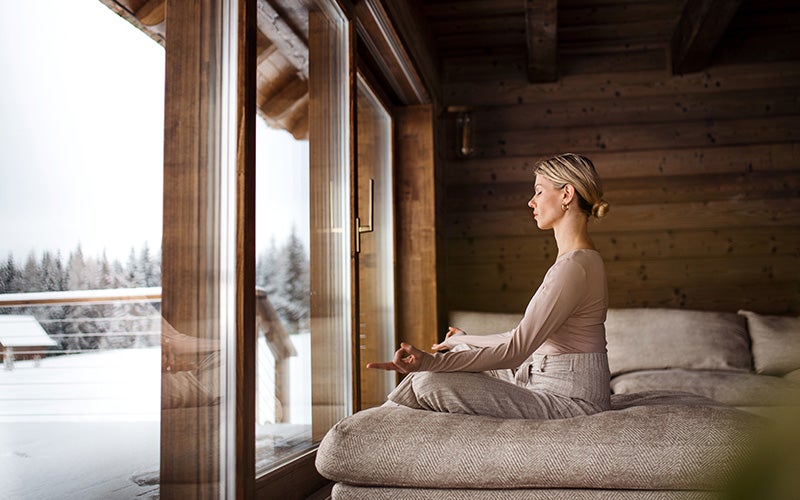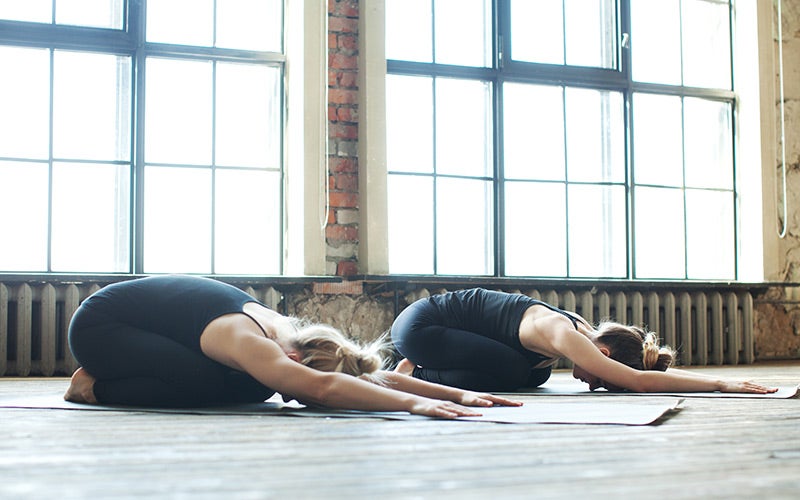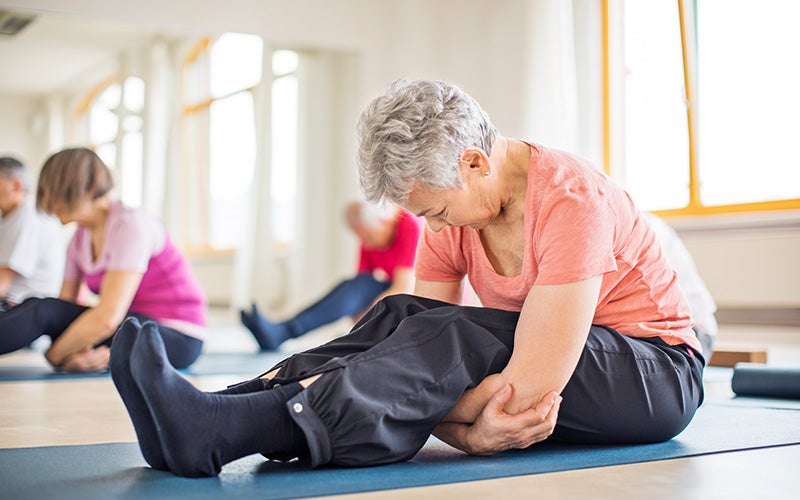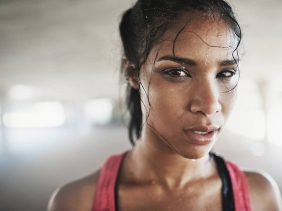The Real Reasons You Should Take Up Yoga This Winter
 ©Halfpoint Images
©Halfpoint Images
Is winter wearing down your motivation to work out? Feeling stressed before the holidays? Then yoga – the powerful, holistic exercise for body and mind – might be the perfect solution for you! Whether you need some meditation to relieve stress, a vinyasa flow to re-energize, or new yoga poses for a challenge, yoga is a great winter sport! Let’s look at why you should definitely try yoga this winter and some exercises you can start with right away.
The arrival of winter brings some big seasonal changes. Many animals go into hibernation, temperatures drop, and plants are covered in snow. We also feel different. We’re affected by getting less light, feeling less active, and (usually) spending less time outside. On sunless days, enjoy some liquid sunlight in the form of our Vitamin Drops D3K2.
Feeling these changes is perfectly normal and doesn’t mean you should spend the entire winter snuggled up in a blanket. Your body needs exercise to feel good and stay healthy. So instead of giving up exercise completely and hibernating until spring, we’d suggest you adjust what you’re doing according to how you feel.
Our tip: Not feeling like a sweaty workout right now? Instead, try a relaxed yin yoga practice that focuses on your flexibility. Or, on the flip side, do you really want to crank up the heat and fire up your immune system? Learn more about Bikram yoga.
Plus, you can’t neglect your mental well-being. Are you under stress right now? Or do you feel listless when it’s cold and dark outside? Yoga connects body and mind in a way that no other sport does. Both a movement-oriented yoga practice and meditation can provide more serenity and calmness in everyday life.
Not convinced yet? Then read on, because we have even more reasons to get on your mat for some yoga this winter!
5 reasons why winter yoga is a great idea
#1 Yoga practice doesn’t require any equipment
The weather outside is frightful and you’d much rather stay cozy at home? We definitely understand that. Good thing you don’t need any equipment for a yoga session, although we still recommend getting a good, non-slip mat to make your practice more comfortable. So make yourself comfortable at home, put on some comfy gym clothes, and roll out your yoga mat.
Our tip: If you’re new to yoga, you can find online classes or you can venture outside and attend a yoga class in a studio. In our article Yoga for Beginners, we’ve rounded up some tips for you to follow along with. Have fun with your yoga session!
#2 Yoga provides warmth in cold weather
When the cold weather gets you down, yoga can help you to generate warmth in your body. Yoga consciously pairs poses with various breathing techniques to create a dynamic flow. As a result, you’ll feel internal heat, work your muscles, and stimulate your blood circulation. Certain asanas have a warming effect on your internal organs or body, too, and we’ll share some favorites.
#3 Yoga keeps you physically fit
It is easy to feel sluggish and slow during the winter months, but that’s all the more reason to stay physically active!
In addition, there are many different types of yoga , so you can challenge your muscles in various ways depending on your mood! For example, a power vinyasa yoga class offers fiery asanas that train your muscle strength and endurance, improve core stability, and burn calories, while hatha yoga focuses on strength, flexibility, and relaxation.

#4 Winter yoga helps you relax
Are you stressed out because you have tons of holiday shopping to check off your list? Are the short days and endless cold months making you feel listless? How about some meditation? Meditating is a key part of yoga and can help you to reduce negative thoughts and stress and bring more peace.
You can also practice meditation apart from a yoga flow. Put on some quiet music or soft candlelight to create a relaxed atmosphere and leave the stress of everyday life behind. If a longer meditation isn’t your thing, you can also settle into a comfortable seat for 2 to 5 minutes after your yoga practice. Close your eyes and observe your breath.
Another way to let go physically and mentally is to lie in Savasana, which is the last asana in a yoga class. Also called “corpse pose,” this one enables you to notice the silence around you and within you and take in any changes you may feel. It is a cool-down unlike any other, and is a relaxing moment free from any thoughts about work, what’s for dinner later, or your to-do list. Here are some instructions for Savasana.
#5 Yoga puts you in a good mood
Less sunlight, cold weather, and spending more time indoors can sometimes lead to lower or depressed moods.
The benefits of yoga on the mind cannot be underestimated. If you are feeling relaxed and balanced internally, you will face your everyday problems with more serenity. In addition, when you do yoga, like with any other physical activity, your body releases happiness hormones. An absolute win-win situation!
Our tip: You are what you eat. So make sure you eat a balanced diet and try to cook fresh meals yourself more often. Short on inspiration for a delicious, healthy meal? Take a look at our free fitness recipes for some fresh ideas.
Balanced and healthy thanks to winter yoga: Yoga poses to get you started
Can’t wait to start practicing yoga? We’re glad to hear it! Here are a few tips and yoga pose ideas to get you started right now.
#1 Learn the right breathing technique
When a friend is overwhelmed, we often remind them to take a deep breath, and it’s not for nothing! Your breathing both has a great influence over and reflects your physical and mental state. If you are relaxed, you breathe slowly and evenly. If you are in a stressful situation, your breathing is usually shorter and shallower.
Breathing is a central component of a yoga practice. The term Pranayama describes the state and control of our breath. If you breathe consciously and with control, you can also positively influence your well-being and bring more peace into your thoughts. In yoga, there are many different breathing exercises. Some are meant to have a stimulating effect, others calming. Some help cool you down, and some warm you up.
One of the most common breathing techniques during your yoga session is Ujjayi breath. Here’s how: Breathe in through your nose and as you exhale, imagine you’re breathing on a mirror to make it fog up. To do this, you need to slightly constrict your windpipe. After a few repetitions, keep your mouth closed while exhaling and breathe in and out through your nose as usual.
You feel a slight friction in the larynx area, which also generates heat. Your tongue should be touching the upper palate. Your breath becomes audible and is slightly reminiscent of the sound of the sea. During your practice, maintain Ujjayi breathing and move in rhythm with your breathing. Every exhalation releases tension.
#2 Seated forward bend for more rest
The seated forward bend, also called Paschimottanasana, is a pose that is suitable for beginners as well as advanced practitioners and is said to have a calming effect. There are several variations of this asana that you can choose depending on your flexibility and what’s comfortable in your body.

Here’s a variation for deeper relaxation:
Sit on the floor, stretching your legs out in front of you. Bend your knees slightly to make sure the position is comfortable for you and flex your feet. Now lean your upper body forward and rest your belly on your thighs. While doing this, hug your legs and keep your upper body, head, and neck relaxed. If the hamstring stretch is too intense for you, bend your knees even more. This variation focuses more on the relaxation in the upper body than the stretch in the back of the legs.
Breathe slowly and intentionally, using the Ujjayi breath. You can hold the exercise for 1 to 3 minutes. The forward bend helps you to direct your energy inwards and symbolizes a conscious “letting go.”
#3 Being in the moment
Holiday shopping and end-of-year stress can constantly bring your thoughts somewhere else. A yoga flow has a meditative effect and allows you to focus on the practice, on yourself, and on the present moment. Block out the rest. Think of your practice as a conscious time-out and a tool for self-care.
To start, you can practice the asana described above, the seated forward bend, focusing only on your body and your breathing. How does your body feel? Can you relax your neck? Where do you feel the stretch? How’s your breath? Observe the effect of the asana on you and your body without judgment and allow yourself to enjoy this moment.
Summary
- Changes in weather and light that winter brings can also have an effect on your body and mind.
- Yoga can help you stay active, brighten your mood, and calm your mind during the winter season.
- There are many different types of yoga that challenge your muscles in different ways, so there is plenty of variety in choosing a practice that is right for you.
- Breathing influences your well-being and is a fundamental practice in yoga.
- Both meditating and a body-oriented yoga practice can help you focus your attention on the present moment and distance yourself from the holiday stress.
More essentials from foodspring:
- Yoga for Beginners: Here’s what to expect from your first session!
- Hatha Yoga: The yoga style for strength and relaxation
- Bikram Yoga: Get hot with this 40-degree yoga practice
- How to reduce stress: 9 amazing tips to bring you to a calmer place
- 9 Yoga Poses to bring relaxation to your life
Sources for this article
We at foodspring use only high-quality sources, including peer-reviewed studies, to support the facts within our articles. Read our editorial policy to learn more about how we fact-check and keep our content accurate, reliable, and trustworthy.






















